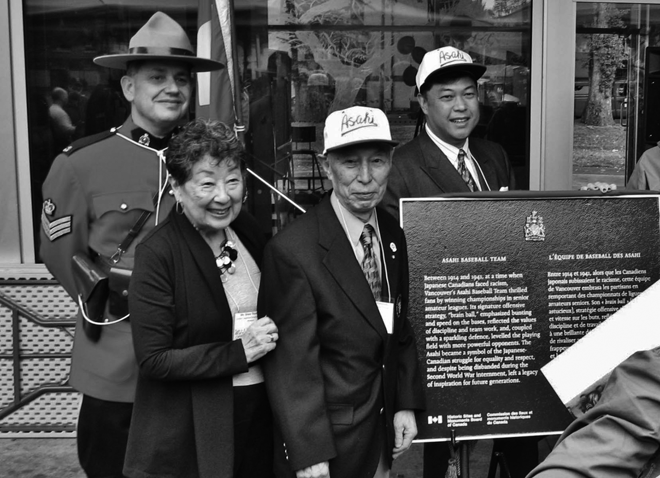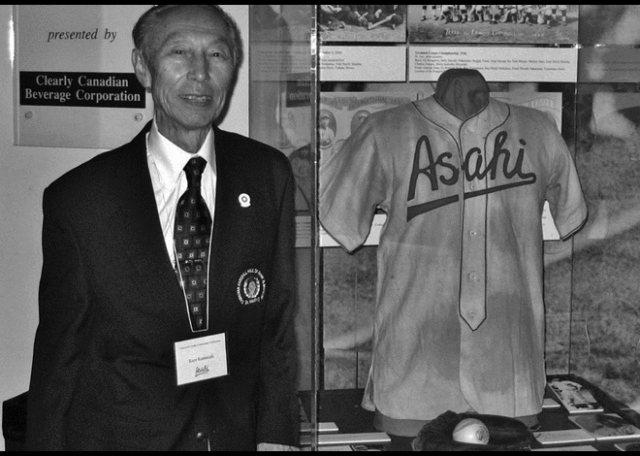By Howard Shimokura For The North American Post
Much has been written and celebrated about the resurrection of the remarkable story of the Vancouver Asahi baseball team of 1914-1941. This retelling of the Asahi story, beginning with the publication of Pat Adachi’s book, Asahi: A Legend in Baseball in 1992, was followed by the release of Jari Osborne’s National Film Board film Sleeping Tigers: The Asahi Baseball Story in 2003, the induction of the Asahi baseball team into Canada’s Baseball Hall of Fame in 2003, and most recently, the release of the Japanese film production Vancouver Asahi in 2014.
Now, in 2015, Kaye Kaminishi of Kamloops, the last man still living who played for the famed Asahi before it was disbanded in 1941, remembers how he started as one of the rookies in 1939 at the age of 17. He played for two seasons until Pearl Harbor forced the Asahi to disband and cut short his baseball career as an Asahi.
“When I got my uniform, I couldn’t sleep all night,” he says. “I was so proud and so happy. The team I dreamed to get into was the Asahi.” In those days, all the young kids dreamed about playing for the Asahi baseball club. Most of the other Asahi players were older, between 25 and 30, and some had been there for seven or eight years. In Kaminishi’s two seasons with the Asahi, they won the Pacific Northwest championship each year.
But why baseball? Why would kids of Japanese ancestry be drawn to baseball in Vancouver in the 1930s? “The Vancouver Japanese community was crazy about baseball,” says Kaye. The players were revered in the community because the team was able to compete and win in a time when the discrimination against the Japanese was intense. The success of the team demonstrated that skill combined with sportsmanship and fair play could win over the Caucasian bias against the Japanese, at least on the baseball field.
Born in Vancouver on Jan. 11, 1922, Kaye learned his baseball basics as a youngster in Japan where he was sent to attend school, a custom common to many Canadian-born nisei. He returned to Canada in 1933 at the age of eleven after his father, a business man and major investor in the Royston Lumber Company on Vancouver Island, passed away suddenly. On his return, he adapted quickly to life in Canada: learning English, attending public school as well as Japanese Language School after public school, and still having time to play sports. He did well in school and he loved sports.
Kaye started playing baseball in the Vancouver Buddhist Church League at the age of 13. He says he played there for “two or three years” and then “went up to the Japanese League” for another “two or three years.” He loved to see the Asahi play and made it a point to go to every game. This was very easy to do, since he lived right across the street from Powell Grounds in the Dunlevy rooming house that his mother owned and operated.
He remembers being scouted by the Asahi and joining the team as a rookie in the 1939 season when he was 17, while he was still attending King Edward High School. Asked why he, out of the many other young players in the community was asked to join the team, he says it was because of his skills in fielding and bunting, prime attributes of the Asahi’s winning ways.
As a youngster, Kaye also played badminton, table tennis, roller hockey, and lacrosse, “but baseball was my sport” he says, and he was always a third baseman. “Somehow, I always played third base, even when I was a kid,” he says. “Even in the Buddhist Church League, I played third base.”
Powell Grounds, the home field of the Asahi that is now Oppenheimer Park, was the heart of Powell-gai, a thriving, bustling community where the Japanese ate, slept, shopped, socialized, and lived. The entire community came to watch the Asahi play. On game days, crowds of fans overflowed the bleachers and stood surrounding the playing field on four sides. And the team had a fair share of Caucasian fans that loved the way the Asahi played and came out to cheer them on.
The Asahi played a style of baseball that was called “brain ball”. Today, it would be called “little ball.” The Asahi players were smaller in stature than virtually all of their opponents, so the home run wasn’t part of their arsenal. Instead, the team relied on getting on base with walks or with bunts, then advancing by stealing bases. Often, the team would win with few hits but superb fielding and base running. A former player said one batter was so exact that “he could bunt with a chopstick wherever he wanted to”. Learning to read, or hear, and smartly follow the signals from the coaches was critical. The Asahi had an advantage. Their coaches gave their audible signals in Japanese.

The Asahi’s cohesive effort and emphasis on teamwork resonated with an important Japanese concept of cooperation and group philosophy. “You couldn’t hit the ball through the infield past them, they were just like cats onto it,” Al Moser, an opposing pitcher with the Downtown Patricias, said in the NFB film ‘Sleeping Tigers: The Asahi Baseball Story’. Moser, six-foot two, towered over the Asahi, who averaged about five-foottwo. “If they did bunt, they were fast as heck. They were thieves,” he said, admiringly. “They’d win a game 3-1 and never have one hit.”
Kaye remembers, “Powell Grounds was so rough that sometimes you didn’t know which way the ball would bounce. The coach told us “If you can’t stop it with your glove, you’ve got to stop it with your chest”. The team intensively practiced the bunt and the squeeze play. Key to the bunt was to make sure to touch the ball with the bat every time.
As one of the youngest Asahi players, Kaye looked up to the other Asahi players as mentors and coaches. He vividly recalls his first success at bat, a misjudged outfield left field fly that went awry when he stumbled between first and second and ended up on second base when he might have made it home. As a third baseman, he was sometimes called the ‘vacuum cleaner’ as he scooped up the ball for throws to first base. He often joined the veterans in the post-game ritual: a hot bath in a local public bath followed by a steak dinner at a nearby Japanese restaurant.
For two years, Kaye was an Asahi. He also participated with the team in the social life of Powell-gai and exhibition games in places like Chemainis, Cumberland, Mission, and Woodfibre. The team thrived as a source of community pride in the era of discrimination against the Japanese. The Japanese Canadian boys and men of the Asahi baseball club were worshipped as gods. Like the Yankees, theirs was a winning dynasty with its own signature style and strategy. Any athlete skilled enough to wear the emblematic ‘A’ of the red and white jersey earned himself a coveted position that came with respect, admiration, and a history of athletic prestige dating back to 1914. In the 1930s the Asahi won the Terminal League three years running and topped the Pacific Northwest League five years in a row from 1937 to 1941.
As the only ethnic, non-Caucasian team to play at a near professional level in several leagues in the Pacific Northwest, the Asahi built a forward-thinking player recruitment program based on teams at mill sites along the B.C. coast. The Asahi also formed a boys’ development program that could have competed in Little League if that had been possible.
This all came to an abrupt end with the bombing of Pearl Harbor. The Asahi played their last game in Vancouver on Sept. 18, 1941. In 1942, the evacuation order came down, the players were dispersed among the many internment camps and the story of the Asahi soon faded away. Although baseball remained a popular sport and pastime in the camps, the Asahi were never again to play as a team.
Photos are courtesy of Haward Shimokura.
Editor’s note: This article was originally published in the Nikkei Images, Volume 20 number 3 (Fall 2015), by Nikkei National Museum and Culture Center (NNMCC) in Burnaby, BC. The writer enjoys researching and writing about the history of Nikkei in Canada. He serves on the Editorial Committee of Nikkei Images. Currently, he chairs the Tashme Historical Project (THP) that is compiling a detailed history of the Tashme Internment Camp, Canada’s largest, established during World War II. In 2016, THP will launch a website of its findings. Howard lives in Vancouver BC.






